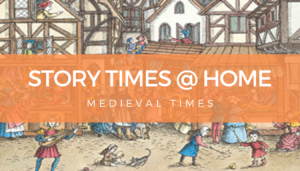
- This event has passed.
E-Learning for Kids – The Amazing Castle
April 20, 2020 @ 11:00 am - April 27, 2020 @ 5:00 pm

Below are resources to help with your child’s e-learning, while also encouraging their imagination to travel back in time. Like most other places, our doors are closed for the time being, but we still want you to explore the fun history behind our changing exhibits, even if it means doing so from home…for now.

During Europe’s Middle Ages, castles were built for one primary purpose: protecting people and property. As you begin your journey into history, ask students to share what they think they know about medieval life, and record their responses on a chart.
Step #1: Research (of course)
The Castle Community
Explain that there existed inside the castle walls a complex community of people who worked, feasted, and played together. Take a look at this worksheet to see what exactly makes up a Medieval Castle. Encourage your child (or children…and peace be with you and upon you) to take a “crayon walk” through a medieval castle by coloring each numbered part as you discuss it. Then have them brainstorm what the structure reveals about how castle dwellers lived. For example, there was little privacy, the community was always prepared for war, animals were kept inside the walls, etc. What do they think it smelled like? Sounded like? Have students write a list of questions like these that they would most like to explore, then start researching the topics that intrigue them the most. Used books you may already have at home, online encyclopedias, museum websites or the Smithsonian Learning Lab. With parent supervision, maybe even find a fun and educational video like the one below!

Step #2 – Organizing our Research
Castle Facts Bulletin Board
As students learn additional details about the Middle Ages, display their research on a clever “Castle Facts” bulletin board. Draw a large stone-castle outline as a guide and graph the towers and walls into rectangles. Cut shapes to match out of construction paper, then keep these colored-paper “building stones” on hand so that each time a student discovers a new fact, he or she can add it to the wall. In no time your class will have built its own medieval castle! Share your “castles” with us by tagging us in your Facebook and Instagram posts or using #UpcountryMuseum.
Step #3 – Let’s make it relevant…
Castle Careers
If you were able to visit The Amazing Castle before we had to close our doors, then you’ll understand the interconnectedness of various roles in communities. Like, Percy the gardener helped Kipper the cook when he grew too many vegetables. Then, Kipper needed to rely on Synge the blacksmith to help mend the hole in his copper pot so he could continue cooking meals for castle community. Now, let’s dig a little deeper and compare it to what we see in our world, our community, today. During the Middle Ages, each job in a castle community filled a specific need. But before a young person could get a job, he or she completed an apprenticeship—rigorous training by an expert in the field. As children research the period, have them list some different medieval jobs and the training required to do them. Talk about how the jobs compare with some modern occupations. Then take a vote to find out for which jobs your kids would most like to have apprenticed. Plot the results on a castle-shaped graph.
Step #4 – Get CRAFTY!
Castle Keeps
 A noble family lived in a castle keep. Talk with your kids about why they think this structure was so named, then have them build their own. For each, you’ll need an empty square tissue box and two paper towel tubes. Guide them to first cut the tops off their boxes, then cover the sides with construction paper, leaving a few inches of paper extending past the tops of the boxes. To make towers, cover tubes with paper and glue to the sides of the boxes. Add colored-paper doors and windows, and personalized flags on craft-stick poles. Kids then can make crenellations in their keeps by cutting notches on the top of the walls and towers. Do a little research in the symbolism of animals and colors to make your child’s castle keep even more personal!
A noble family lived in a castle keep. Talk with your kids about why they think this structure was so named, then have them build their own. For each, you’ll need an empty square tissue box and two paper towel tubes. Guide them to first cut the tops off their boxes, then cover the sides with construction paper, leaving a few inches of paper extending past the tops of the boxes. To make towers, cover tubes with paper and glue to the sides of the boxes. Add colored-paper doors and windows, and personalized flags on craft-stick poles. Kids then can make crenellations in their keeps by cutting notches on the top of the walls and towers. Do a little research in the symbolism of animals and colors to make your child’s castle keep even more personal!
Step #4 – Homework…wait…extra credit
Page-to-Knight Time Lines
Of all medieval professions, knighthood was one of the most important, as knights defended the castle household. Have students create time lines to illustrate the long and involved process of becoming a knight in medieval times. Typically, a boy of seven moved to a relative’s castle and became a page. At 15, he became a squire. He would be dubbed a knight around his 21st birthday. If your kid is especially interested in knights, have them research each stage in this process for the time line. What would a boy learn in each stage? What would that boy being learning at your child’s age?



